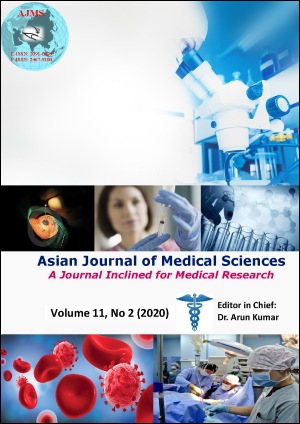Effect of smoking on visual evoked potential (VEP) and visual reaction time (VRT)
Keywords:
Visual Evoked Potential (VEP), Visual reaction time (VRT), SmokersAbstract
Background: Nicotine in tobacco smoke causes demyelination. Again, hypoxia in long-term smokers is linked to neuropathy. Visual receptors are early sufferer of neuropathy. Visual-Acuity & other ocular tests often fail to detect subtle changes of neuropathy which, however, can be detected by VEP test. Literature review shows that changes in VEP come earlier than PFT changes in smokers. Ironically, smokers claim that smoking improves their reaction time, which can be assessed by VRT.
Aims and Objective: To relate smoking status with VEP and VRT. Materials and Methods: Fifty-six subjects (smoker group = 28 & non-smoker group = 28), whose age & sex were matched, were included in the study. Their PFT, pattern VEP of both eyes & VRT were recorded. The data were compared between the two groups using unpaired t-test, considering statistical significance at p<0.05.
Results: The FVC (4.35±0.83 vs. 5.32+1.18 l, p=0.022), FEF 25% (7.40+2.38 vs. 8.74+3.90 l/s, p=0.019) & FEF 50% (6.11+1.52 vs. 7.74+2.57, p= 0.010) were significantly lower in smokers compared to nonsmokers. There was no significant difference in P100 wave latency of VEP. But, VRT of smokers were significantly shorter (431.69+60.29 vs. 441.14+123.54 ms, p=0.010).
Conclusion: Smokers have shorter visual reaction time and similar visual evoked potential as compared to non-smokers.
Downloads
Downloads
Published
How to Cite
Issue
Section
License
Authors who publish with this journal agree to the following terms:
- The journal holds copyright and publishes the work under a Creative Commons CC-BY-NC license that permits use, distribution and reprduction in any medium, provided the original work is properly cited and is not used for commercial purposes. The journal should be recognised as the original publisher of this work.
- Authors are able to enter into separate, additional contractual arrangements for the non-exclusive distribution of the journal's published version of the work (e.g., post it to an institutional repository or publish it in a book), with an acknowledgement of its initial publication in this journal.
- Authors are permitted and encouraged to post their work online (e.g., in institutional repositories or on their website) prior to and during the submission process, as it can lead to productive exchanges, as well as earlier and greater citation of published work (See The Effect of Open Access).




